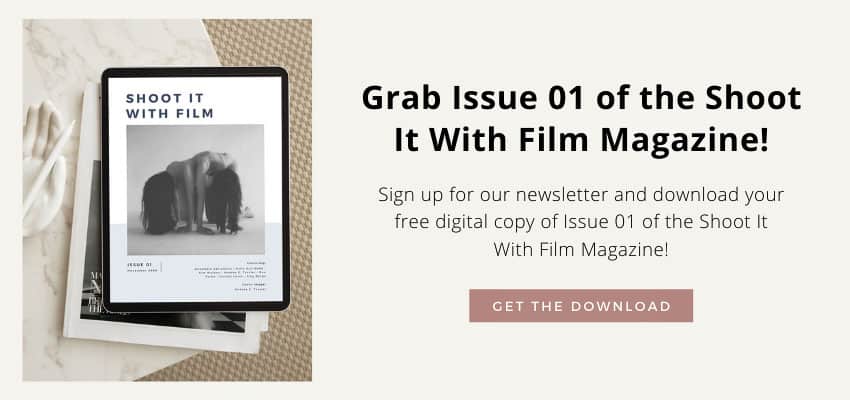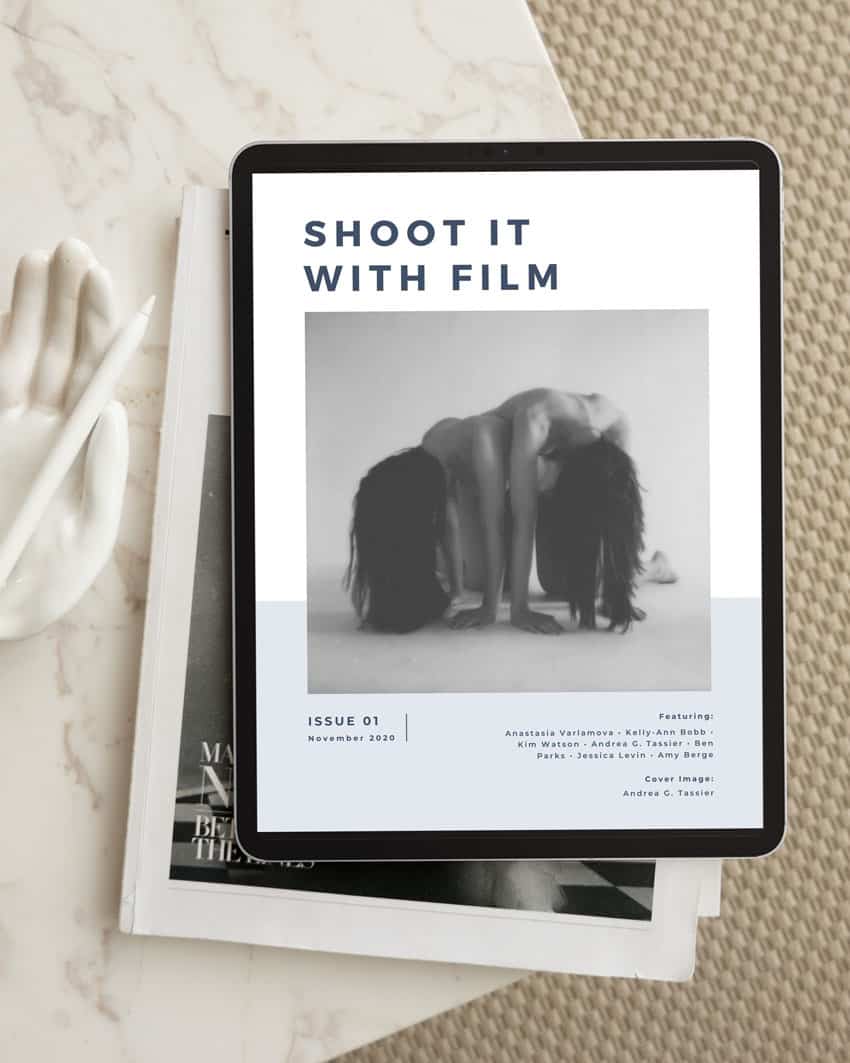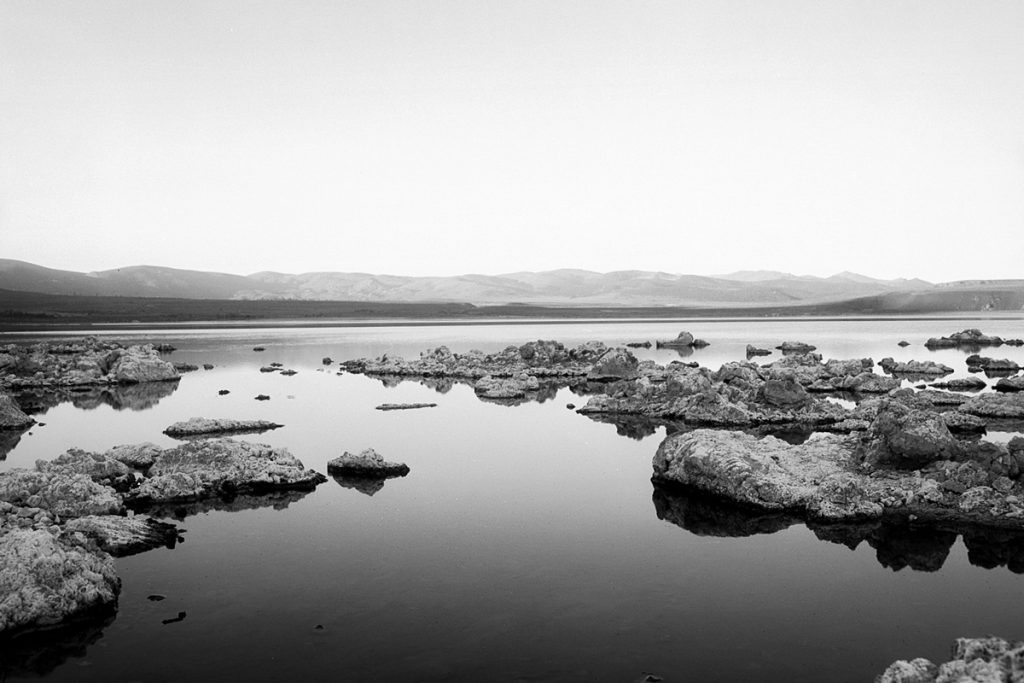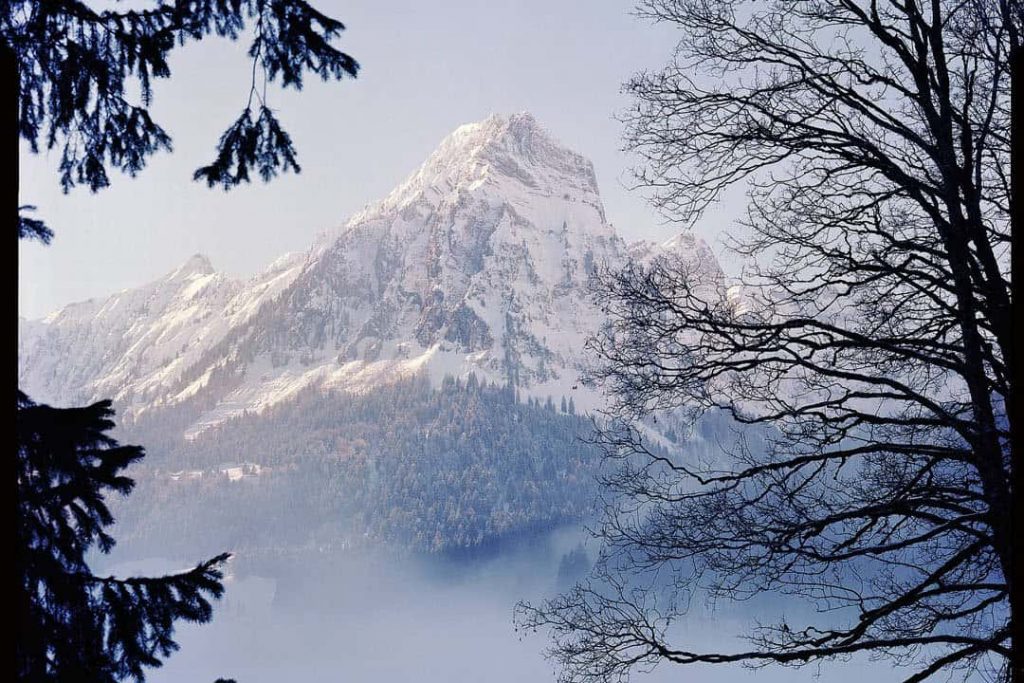
Written by Taylor Blanchard
About the time I started printing in the darkroom, I acquired my first medium format camera: a Holga 120S. The more I printed my negatives, the more I gravitated to 120 film.
I love printing on 11×14 and 16×20 paper, and I realized that larger negatives can make much crisper, larger prints. I started imagining the possibilities of even larger negatives.
Captivated by the beautiful designs of large format cameras, I was overcome with romantic notions of working with cameras steeped in photographic history. However, I also felt intimidated and therefore apprehensive to dive into the format.
Every time I would research large format, I would become more overwhelmed.

My First Attempt with Large Format Film Photography
After getting a handle on the basics, I finally took the plunge and bought an Anba Ikeda folding 4×5 field camera – a classic cherry wood camera – a bit dinged and obviously well-loved.
When the camera arrived, I was so excited that I immediately purchased film. We were going to Folly Beach in South Carolina for a long winter weekend, and I had visions of setting up the camera at the ocean’s edge, composing photos of the beautiful gray vastness.
Then I tried to open the camera. I had no idea what I was doing. When I finally opened the camera, it was so fussy – I didn’t know which knobs to loosen and which to tighten. I struggled to get the lens in place. Once I had the camera open, I couldn’t get it closed again.
I quickly realized I wasn’t quite ready to take the camera on that particular trip.


Building Confidence Through Practice
When we returned, I set about the process to learn everything I needed.
I spent a few days practicing with the camera in our living room: setting it on the tripod, opening it, attaching the lens, metering, focusing, setting the aperture and shutter speed on the lens, inserting the film holder, removing the dark slide, pressing the cable release, and putting the dark slide back in.
When I was finally comfortable with the camera, I practiced loading and unloading the film holders in the light with my eyes closed (I wasted a piece of film for this) and then in my changing bag. I also practiced getting the film onto the Mod54 film processor for the Paterson 3-reel tank.
If you want more info on the basics of large format, check out this article here.


I was finally (I hoped) ready and devoted a few afternoons to taking photos in Charlotte where we live.
I shot CatLabs X Film 80 to start, which is moderately priced for sheet film. I recommend starting with a less expensive film when you first start shooting large format, so it’s less painful if you make a mistake.
When it was time to develop, I was so focused on successfully getting the negatives onto the film processor that I didn’t use enough chemistry in the tank (750 ml instead of 1000ml), which yielded uneven negatives.
Nonetheless, there was enough detail to know the negatives were properly exposed, which gave me confidence.
After several successful outings with black and white, I ventured into some higher-priced color film: Kodak Portra 160 4×5 sheet film and Kodak Ektar 100 4×5 sheet film.
I was blown away by my first color images from the camera. The colors! The range!


Printing Large Format in the Darkroom
Printing 4×5 in the darkroom has certainly lived up to my hopes. One unexpected joy is making contact prints on small paper stock.
For enlarging, I am just as amazed as expected about the range of tones and how easy it is to get a crisp image even at larger paper sizes.
I’ve not necessarily found it easier: I still need to do just as much work with contrast filters, split filter printing, and dodging and burning. After a few years of printing on RC photo paper, I’ve also been printing on fiber paper to get the full range of tones and contrast.
Also unexpected: I still want to shoot 120 and even 35mm, and have a newfound appreciation for small prints, which can feel more intimate and full of small details.


Embracing the Journey & What I’ve Learned
Beyond the basic operation of the camera, there is always something new to learn with large format.
My approach has been to tackle each aspect of large format as it arises. For example, I first used a very flimsy tripod, and then realized it wasn’t sturdy enough, so I started researching tripods suitable for large format cameras.
I also was getting vignetting on many of my early images, which led me to learn about image circle — or how much coverage a lens provides your negative to allow for camera movement.

Setting up a large format camera in the field will certainly elicit stares and often comments or questions. I’ve also realized that simply telling someone “this is a 4×5 camera” or “it’s large format” does not really explain what it is.
Many people don’t know there is film larger than 35mm. It’s a fun opportunity to strike up a conversation and talk about film, and people will often share stories of their own film camera, or their parents’ or grandparents’ cameras.


Film is a slower process, and 4×5 photography slows down the process even further. Because it takes longer to set up the camera and take a photo, I spend more time pre-visualizing what I want to capture.
I’ve also been very conscious to not take a photo if I set up the camera and don’t see my vision. It’s helpful to have a 35mm or medium format camera with me in those instances, so I can still take a photo.
Since buying the camera, I’ve taught my husband Marc what I’ve learned. He also loves taking film photographs, and we have a good routine in the field to set up the camera. I haven’t yet convinced him to load the film holders or develop the negatives though!

Almost a year into my large format journey, I’m still learning and getting comfortable, but it’s been an incredible part of my photographic journey. I’ve learned a lot about reading the light in a scene.
Any wagers on how long before I want to buy an 8×10 camera?

Thank you so much, Taylor! Taylor is a regular contributor here at Shoot It With Film, and you can check out her other articles here.
You can also check out Taylor’s work on Instagram.
Leave your thoughts and questions about large format film photography below in the comments!








Blog Comments
Matt
January 20, 2023 at 10:35 am
As for wagers, I’d guess you’ve already looked… If only out of curiosity.
Taylor Blanchard
January 22, 2023 at 8:08 am
Matt – ha, yes definitely! I think two things are holding me back: having to buy new film holders and lenses for 8×10. But, I am sure it will happen eventually.
Cami
January 20, 2023 at 10:36 am
Fantastic article, Taylor!! I’m dying to try large format. You make the experience sound so magical and worth the hard work.
Taylor Blanchard
January 22, 2023 at 7:56 am
Cami – it really is magical and I think you would love it. You could get some great photos in your studio space too!
Ray Goulter
July 6, 2024 at 9:56 pm
Taylor, I was so pleased to read of your initial foray into LF! I’ve had a number of 4×5 cameras, now owning a Chamonix 4×5. It fits comfortably into my Lowepro backpack along with 90mm, 150mm and 300mm lenses, plus some Lee filters (red, green, pol, grad ND), grey card, Profisix light meter, a Phenix 50mm lens I converted for critical focus on the ground glass, lens cleaning blower brush + chamois cloth, and a bulb-operated extension release about 5m long. A small aluminium box takes about 20 film holders plus, importantly, a notebook to record exposure data and later development data. Try and get a good Grafmatic film holder (6 sheets 4×5) and learn to load and use it with ruined 4×5 sheets before using it for real. I have a dedicated medium-weight movie tripod for the camera (no tilt, it’s not needed with a LF camera). Read up on the Scheimpflug principle. Sharpness is not so much a consideration with LF, whereas tonal range is. Re: 8″x10″. My Sinar P2 (4×5 and 8×10 backs) isn’t suitable for field work, and I recently was given a Linhof Kardan Standard 8×10 camera missing its rail (I fortunately got one through the Internet) and a compendium in a very poor state – falling apart! I’m about to purchase a replacement compendium bellows then I can take it in the field. Film holders and film for 8×10 are rather expensive so obtain and use judicially! Likewise lenses with the correct ‘throw’. A tip for measuring light when using filters: firstly place the filter in front of the light meter to take both incident and reflected readings. Average the readings for exposing film. Place the filter on the camera lens before exposing the film. This saves having to re-calculate exposures using different filter factors. I’ve been doing all my own darkroom work for about 60 years, starting with 35mm Ilford FP3 b&w film. A huge welcome to LF photography, you won’t regret the never-ending learning process notwithstanding occasional failures!
Taylor Blanchard
July 10, 2024 at 6:31 pm
Wow Ray, what a detailed and thoughtful comment – I appreciate your insights. It’s definitely a never-ending learning process. I love your tip about metering with filters – brilliant. I’m familiar with some of the products and items you mentioned, but clearly have a lot more research to do! Thank you again.